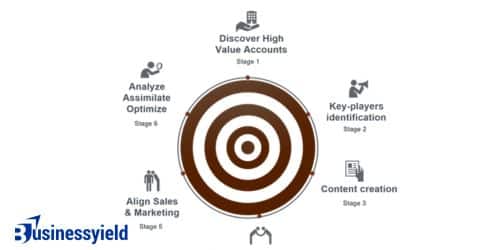Increasing your exposure and sales by focusing on the correct accounts and engaging with key decision-makers. That seems good, right? In this piece, we’ll discuss the advantages of account-based marketing and how to develop an ABM plan.
What is Account-Based Marketing (ABM)?
Account-based marketing (ABM) is a strategic strategy for targeting high-value accounts in a market or organization. ABM strategies are centered on generating individualized purchasing experiences to improve customer acquisition, relationship building, and business success.
ABM enables your firm to work and connect with high-value accounts as if they were independent marketplaces. This, combined with personalizing the buyer’s journey and tailoring all messages, content, and campaigns to those unique accounts, will result in increased ROI and customer loyalty.
Key Takeaways
- Account-Based Marketing (ABM) is a strategic approach focused on targeting and engaging high-value accounts with personalized buying experiences to foster customer acquisition and loyalty.
- ABM aligns marketing and sales efforts, ensuring consistency in communication and interactions across targeted accounts, enhancing customer experience and efficiency.
- Customizing content and campaigns for each high-value account increases a company’s relevance, positioning it as the most suitable solution for the target accounts’ needs.
- ABM allows for precise ROI measurement for each targeted account, aiding in strategic decision-making and future targeting efforts.
- By focusing on selected high-value accounts, ABM streamlines the sales process, making it more efficient and increasing the potential for business growth through deepened account relationships.
Advantages of Account-Based Marketing
- Maintain marketing and sales alignment.
- Increase your company’s significance with high-value accounts.
- Provide consistent customer experiences.
- Determine your return on investment.
- Streamline the sales process.
- Increase business through account connections.
Account – based marketing has numerous advantages. We collected this list of beneficial outcomes for all types of organizations.
#1. Maintains marketing and sales alignment.
Cross-team collaboration and enhanced communication are beneficial for any organization’s growth. In account-based marketing, transparency and alignment will confirm that your marketing and sales teams are working toward the same goals, staying within the mutually agreed-upon budget, and understanding the precise roles of each internal stakeholder.
This alignment ensures that all communications, interactions, and content are consistent for the accounts you work with. This means that no matter how long an account has been with your firm, your team members can take up where others left off at any point without inquiry, resulting in a smooth and pleasurable client experience.
#2. Increases your company’s relevance with high-value accounts.
Account-based marketing necessitates personalizing everything (including content, product information, communications, and campaigns) for each account where you invest your resources. This customization maximizes your relevance among these accounts.
That’s because your content and interactions are personalized to demonstrate how your specific products, services, and other offerings may help people overcome their difficulties. This means, ABM enables you to position your company in a way that makes it the most relevant and optimal alternative for your target accounts.
#3. Provides consistent consumer experiences.
To make your ABM approach stand out, you must instill a lasting sense of delight in your accounts. Each account should feel like a one-to-one market for your brand. Address this by providing consistent customer experiences.
ABM is a strategy that necessitates significant alignment between sales and marketing; focus on this when attempting to offer consistent experiences. Confirm that all team members understand where an account is in the buyer’s journey; then, provide targeted and timely communication, campaigns, product information, and pricing data.
#4. Assesses your return on investment.
Account-based marketing allows you to simply calculate the return on investment (ROI) for each account into which you put resources and time. This is useful since it allows you to determine whether specific accounts you invested in were appropriate for your business.
Then, you may nurture and delight those accounts over time to keep them, as well as recognize and target similar accounts in the future. If your ROI shows that the ABM methods you deployed were effective, use that information to drive your plan forward.
#5. Streamlines the sales process
Depending on your firm, industry, and resources, the sales cycle usually looks like this:
1) Prospecting 2) Connecting 3) Researching 4) Presenting 5) Closing 6) Delighting
This cycle is streamlined with account-based marketing; by focusing your efforts on certain high-value target accounts, you save time and money, allowing you to devote more time to the stages of the cycle that positively impact your bottom line.
#6. Identify target accounts, present to them, close them, and delight them.
ABM improves your sales cycle by allowing you to stay efficient. Rather than experimenting with various strategies to prospect and qualify a vast pool of leads, ABM ensures that the accounts you target are appropriate for your company and vice versa. Your marketing and sales alignment, as well as the consistent and tailored customer experiences you provide, all help to streamline the sales cycle.
#7. Increases your business through account relationships
The phrase “quality over quantity” pertains to account-based marketing. The approach necessitates investing substantial time and resources in engaging and delighting a group of carefully selected, high-value accounts, as opposed to attempting to close transactions quickly with less-qualified leads who may not be the best fit for your firm in the long run.
By taking the time to develop these trustworthy connections with accounts, you will increase your business by keeping those key customers longer. And, because it costs more to acquire customers than to retain them, this will benefit your bottom line.
Furthermore, as a result of individualized, intelligent, and consistent customer experiences, accounts will develop loyalty to your company over time, and loyal customers are your finest marketers, promoters, and brand advocates. In other words, your accounts will help you grow your business within their networks (such as partners or customers) through referrals, word-of-mouth marketing, testimonials, and other means.
Let’s start with the steps to creating an account-based marketing strategy.

Steps To Creating an Account-Based Marketing Strategy
When marketing and sales have similar thinking – how to target and land accounts – they may work together toward a single goal. The first stage is to co-create an ABM strategy so that sales and marketing may collaborate as part of a combined “account team.”
At a high level, this means that marketing allocates its funding to the accounts that sales consider the most significant. Sales and marketing agree on shared objectives, messaging and content, execution strategies, and success measures. Let’s go over the fundamental steps of creating an ABM plan.
Step #1. Identify high-value accounts
Analyze your current client base to determine which ones meet your description of an ideal customer. This description can vary based on industry and other broad descriptors, but it frequently comes down to the most profitable, long-term, satisfied customers who are a pleasure to work with. In other words, they are a good fit for your organization, have success with your solutions, and provide the most lifetime value.
Keep a lookout for existing accounts that have shown a willingness to grow their presence with your organization, as well as new accounts that meet your strategic objectives. For new accounts, you may answer the question, “Does this account have an urgent need that we can meet that would compel it to spend $X amount?”
Step #2. Map individuals to accounts
In each B2B transaction involving a large purchase, your marketing and sales teams must help drive consensus among key stakeholders. Your first step is to identify those who can influence the ultimate purchasing decision. These are the committee members you should approach and encourage to take action.
For example, suppose a corporation offering marketing software is identifying important decision-making roles within specific accounts. The list of individuals could include the CMO, digital marketing managers, CIO, and CFO.
Remember that while individual connections are essential, they must be considered within the context of the entire account. In other words, you must relate each member of the buying committee’s concerns and needs to their company’s strategic purpose. The primary purpose of engaging each stakeholder is to help drive consensus for a purchase decision.
Step #3. Define and build targeted campaigns
Once you’ve identified your target accounts and people, you’ll need to create targeted advertising that will appeal to them. Keep in mind that developing and maintaining connections is essential for a successful ABM program. You are more likely to succeed if you provide excellent consulting and education that is tailored to the account’s purchasing cycle.
It begins with matching your communications and content to the interests, needs, and difficulties of each account and key stakeholder. Ideally, you should create a distinct value proposition and appropriate information for each stakeholder who influences purchasing decisions.
Incorporate ample thought leadership content into your content strategy:
- Learn what stakeholders believe: Start by researching the current state of the topic so you can meet your reader where they are.
- Create and articulate an informed point of view: Make a compelling case for your stance and demonstrate that you have the authority to take a firm stand.
- Frame your tale in terms of the value delivered: Back up your claim with real-world examples that show your ideas in action.
If your communications and content are relevant, buying committee members may share them with their colleagues. Truly tailor the message to each individual on an account. By doing so, you establish your organization as a reliable advisor and partner who has done its homework and is delivering relevant information and counsel.
Step #4. Identify optimum channels
Determine which channels your target accounts and key stakeholders primarily utilize to investigate trends and solutions. This may differ by function or industry, so don’t assume you can take a one-size-fits-all strategy here.
Step #5. Create a Strategic Playbook
To clarify roles and duties, create a playbook outlining who does what and when. Specify the strategies that both marketing and sales will employ to engage contacts within accounts and generate interest and activity. Give this significance by creating a marketing cadence that associates each communication/outreach with the right channel, message, or content.
Step #6. Execute Your Campaigns
Marketing and sales interact with accounts on an individual basis, utilizing a personalized strategy that is appropriate for each encounter. Campaigns can use a variety of strategies, including email, special events, direct mail, advertisements, and more. Use relationships to direct your outreach, as they are the foundation of the ABM strategy.
For example, a specific team member may reach out because they attended the same college or have the greatest professional contacts with the contact. That team member can then make introductions to the account’s owner.
Step #7. Measure and Optimize
Measuring ABM results differs from measuring the impact of traditional lead generation strategies. When it comes to ABM, marketing, and sales are jointly accountable for driving pipeline and revenue. You’re interested in moving accounts, not individuals, through the buying process.
In addition to tracking account interaction, keep track of prospects’ created and closed deals, as well as their worth. Allow your staff adequate time to produce results, following the average buying cycle, and then change your strategy and tactics as needed.
You can use the template below to develop your account-based marketing strategy.
Inbound Marketing and Account-Based Marketing
Despite being a stand-alone marketing strategy, account-based marketing incorporates elements of other marketing methods. For example, ABM is related to inbound marketing, and the two tactics complement each other.
With inbound marketing, you develop valuable, informative, or educational material that leads typically discover through organic search, social media, or paid search. This is excellent for driving new leads to your company, but inbound marketing can also stimulate the curiosity of contacts at your target accounts for ABM.
This is why an effective account-based marketing plan must be built on inbound marketing principles. Inbound marketing enables you to meet your prospects where they are and show them the material they want to see when they want it.
Your team will most likely utilize a combination of inbound and ABM methods to reach more people in your target audience. As long as it makes sense for your business, these two tactics should operate concurrently. Some brands use 80 percent ABM and 20 percent lead-based marketing. Some brands have the ratios reversed, while others are 50/50. It is entirely dependent on the firm, its resources, its maturity level, its objectives, and the products or services it offers.
With ABM, marketers, and salespeople work together on a single plan before coordinating account-based experiences as a revenue team with common goals.
Account-Based Marketing Examples
Every company uses account-based marketing differently. To develop an effective ABM strategy for your firm, look at how other companies use account-based marketing.
DocuSign is a fantastic example of account-based marketing. It developed distinct websites for each of the six industries it wished to target. It then drove its target contacts to these websites via display ads. DocuSign knew exactly who would visit these unique websites, so it loaded them with highly targeted content, which significantly enhanced conversions.
GumGum, a contextual intelligence business, targeted a T-Mobile account. Its team built a unique superhero comic book with the T-Mobile CEO as the hero of the plot. GumGum’s comic book went viral, and it secured the T-Mobile account.
Account-based marketing isn’t limited to digital channels. Intridea, a product design company, intelligently purchased a billboard in front of the Ogilvy New York City offices to capture the brand’s attention, and it worked.
Types of Account-Based Marketing
ITSMA is largely regarded as pioneering the ABM approach in the 2000s. It has identified three ABM methodologies that firms use: strategic, light, and programmatic.
#1. Strategic ABM
This method is used on a one-on-one basis, usually for highly strategic accounts. Relationship building is a key component of strategic ABM. As a result, this strategy focuses significantly on tailored marketing initiatives that demonstrate a thorough understanding of the target audience.
#2. ABM Lite
The ABM Lite technique enables large-scale ABM efforts. In this edition, the emphasis is on lightly personalized/customized advertisements directed at a limited group of similar accounts.
For example, accounts of similar size facing equivalent difficulties and pursuing analogous activities may receive the same messaging and creativity.
#3. Programmatic ABM
You could say that programmatic ABM blends strategic and light ABM by using cutting-edge technologies to tailor marketing campaigns for target accounts on a large scale. This strategy is typically used in conjunction with a focus on a certain horizontal or vertical part.
Depending on your organization and the sophistication of your ABM program, you may find it more effective to use only one strategy or a combination.
Common Obstacles to ABM Success
While launching an ABM program requires deliberate effort and upfront work, success is achievable for every B2B firm. So, why do some companies struggle to maximize their income potential with ABM?
#1. Failure to align with the appropriate target accounts
It’s a fact that if marketing and sales don’t agree on the same target accounts, all of the benefits of ABM are lost. ABM works partly because of the combined power of marketing and sales, which are hyper-focused on the highest-potential accounts. If you fail to get this core piece of your ABM program in order, all of your other program methods will be ineffective.
Using a shared source of data about target accounts goes hand in hand with identifying the appropriate target accounts. If marketing is using its marketing automation system of record and sales is using CRM to identify target accounts, it’s no wonder that the two divisions are out of sync.
#3. Unrealistic aspirations
If you expect your ABM program to revolutionize the buying cycle and your sales overnight, you’ll be very disappointed. Instead of expecting miracles, set achievable goals. Until you iron out all the kinks and your ABM program gets into high gear, you’re more likely to witness incremental gains than mind-blowing outcomes. You’ll be on the correct track as long as you keep moving upward.
Creating Buyer Personas for ABM
- Gather Data: Start by analyzing your best customers and identifying common characteristics.
- Interview Stakeholders: Conduct interviews with current clients to understand their pain points and what attracted them to your solution.
- Develop Personas: Create detailed personas for each decision-maker within your target accounts, focusing on their roles, challenges, and goals.
Tailoring Content for ABM:
- Use the insights from your buyer personas to create content that addresses the specific needs and pain points of each role within your target accounts.
- Develop case studies, whitepapers, and blog posts that speak directly to the unique challenges faced by your targeted industries.
Latest ABM Trends and Technologies
- AI and Machine Learning: Artificial intelligence and machine learning are revolutionizing ABM by enabling more sophisticated account targeting, personalized content creation, and predictive analytics for better decision-making.
- Account-Based Experience (ABX): ABX is an emerging trend focusing on delivering a cohesive and personalized experience across all touchpoints with an account, further blurring the lines between marketing, sales, and customer success efforts.
- Intent Data: Using intent data to identify which accounts are actively researching topics related to your products or services allows for timely and relevant engagement, increasing the chances of conversion.
Conclusion
One aspect of account-based marketing strategy is frequently overlooked in discussions.
With so many tools and access to so much information, it’s easy to forget that you’re still working with humans.
Whether your target client is a B2B employee or a retail customer, we are all still humans selling to one another.
Account-based marketing may be most effective for business clients, but the goal remains to develop personal relationships with important stakeholders and decision-makers.
Do not allow humans to become lost in the data.
As you continue with your ABM program, keep in mind that people, not organizations or numbers, are your ultimate targets. Concentrate on the people who have a real-time influence over the purchase of your goods or services. Your relationship-building efforts will be more authentic and effective if you connect the dots and get a comprehensive picture of each individual on your target account list.
- Mastering the Art of Strategic Leadership: A Comprehensive Guide to Developing Essential Skills for Success
- Unveiling the Strategic Advantages of Product Feed Management for Businesses
- Mastering Business with Strategies from Hearts and Other Card Games
- A Proven Guide to Conversion Rate Optimization (+ CRO Checklist)






